Words & visuals by Reema Najjar
Autumn leaves sweep Toronto’s view––a blanket of brown, red and patches of green take over the city’s downtown core. Through the cool haze of a September Saturday night, the waning crescent rises as a darker side of the moon casts a shadow onto Toronto’s white night––translated from the French words ‘nuit,’ meaning night, and ‘blanche,’ meaning white, otherwise interpreted as ‘sleepless night’ for the all-night event.
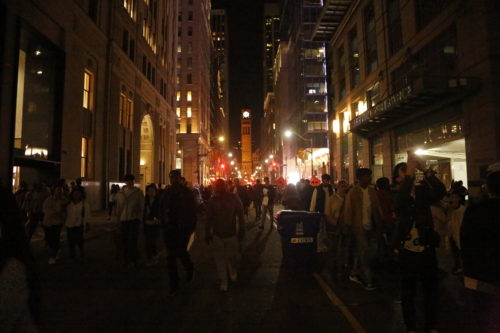
This year’s 17th annual Nuit Blanche celebrates Toronto’s contemporary art. The free public exhibition invites you to interact with embodied works all night long from 7 p.m. to 7 a.m. On Sept. 23, art seizes the city’s public spaces in all of its boroughs. Torontonians weave and sprawl throughout as art sparks narratives surrounding the event’s theme—“Breaking Ground.”
Venturing into the night, Alexandra Li, a first-year Toronto Metropolitan University (TMU) English student and first-time Nuit Blanche-goer, seeks standard gallery features like sculptures and paintings. The sheer amount of people and art––and people viewing art––distracts Li’s interpretation of the exhibitions she’s able to visit.
Downtown Toronto’s bright lights dim, and the city dwellers and visitors disperse. Overwhelming flashing phone cameras dance on peripheral visions and sensory spectacles draw in crowds.
Reaching the event’s peak, the clock strikes midnight and Li hopes to soak up all she can. While immersed in the city itself, as a viewer, not only are you asked to experience the physical art, but allow the art to experience you. The sculptures and art pieces metaphorically invite you into their space.
Li, along with her crew, only attends two installations. First, she cluelessly barges into what seemingly is the middle of a show, witnessing a more “emotional” performance. Voices muffle, sounds don’t echo as they could have and the group leaves feeling shaky—still searching for meaning.
Though Li is intrigued, she’s dazed, confused and well, sort of scared. She joins a large, mysterious huddle of fellow Torontonians around what appears to be straw at first glance. The Circle of Enquiry in a Dish With One Spoon stares down the audience while a video called Eclipse streams in the background.
Eclipse by Naomi Rincón Gallardo rolls—a beheaded man, scarcely clothed, conducts a military training routine. In this performance art piece, themes of Canada’s history of militarism loudly boom and according to the city’s webpage, it “alternates with a dance of wounded humanity.” A group of “obsidian butterflies with flint-tipped wings from the nocturnal and subterranean world” emerge from their chrysalis in “a threatened landscape, amid climate catastrophe.”
Li interprets Eclipse as disturbed rather than enlightened. Without contextual information about the installation, Li and her peers meet confusion and some fear once again.
It’s clear that Eclipse isn’t her favourite work, due to the unprecedented shock of nudity and tones of violence, Li leaves stunned.
“I don’t think I can say what the video is because I didn’t really understand it myself,” she says. “I found it really a bit scary almost in a way, because again, we didn’t have any context. It was just a video that started playing and there was a lot of nudity we didn’t expect.”
Li feels distanced from the performance, taking away mythological tones but not resonating with the installation’s point.
With some frustration, Li describes the actor in the video, seen in his underwear and wearing a mask, as a sort of “sexual actor.” She recalls “different faces” flashing “like paintings on bodies.”
Public art demands your attention. It lives where you live. It occupies the land that settlers occupy in Toronto and reclaims stolen land for Indigenous artists and art-enjoyers. Some TMU students––although open-minded––might miss the right context required to be immersed in the experience of a public art-saturated event like Nuit Blanche. Blindspots, biases and prejudice are all possible for anyone who is not yet geared with the critical tools necessary when interpreting this year’s exhibit, but that’s part of the event’s purpose. This year’s theme invites visitors to ask questions like “What role does art play in our public, colonial space?” And “Why should you care if you don’t understand it?”
According to an article published on the Canadian Art webpage, writer Sean Neil highlights the four largest public art museums in Canada, evaluating them in terms of attendance and budget of operations. He looks at the Montreal Museum of Fine Arts, the Art Gallery of Ontario (AGO), the National Gallery of Canada and the Vancouver Art Gallery.
Surveying the four major art exhibits, Neil found that of the 77 board trustees across all four museums, 96 per cent are white. In relation to Toronto, the AGO has no Indigenous representation on the board. With respect to these statistics, the importance of the representation of Indigenous art by Indigenous people remains crucial when it comes to opportunities like Nuit Blanche.
With a newly found intrigue in local art, some artists ask visitors to investigate initiatives that speak to them and their environment. With the various mediums of art today, students shouldn’t feel limited in their scope but encouraged to critically observe when meeting with demanding artworks that initially beg for a challenge. Colonialism is not a light topic—at all—which is why the darker shadow aims to highlight that grim focus in this year’s event.
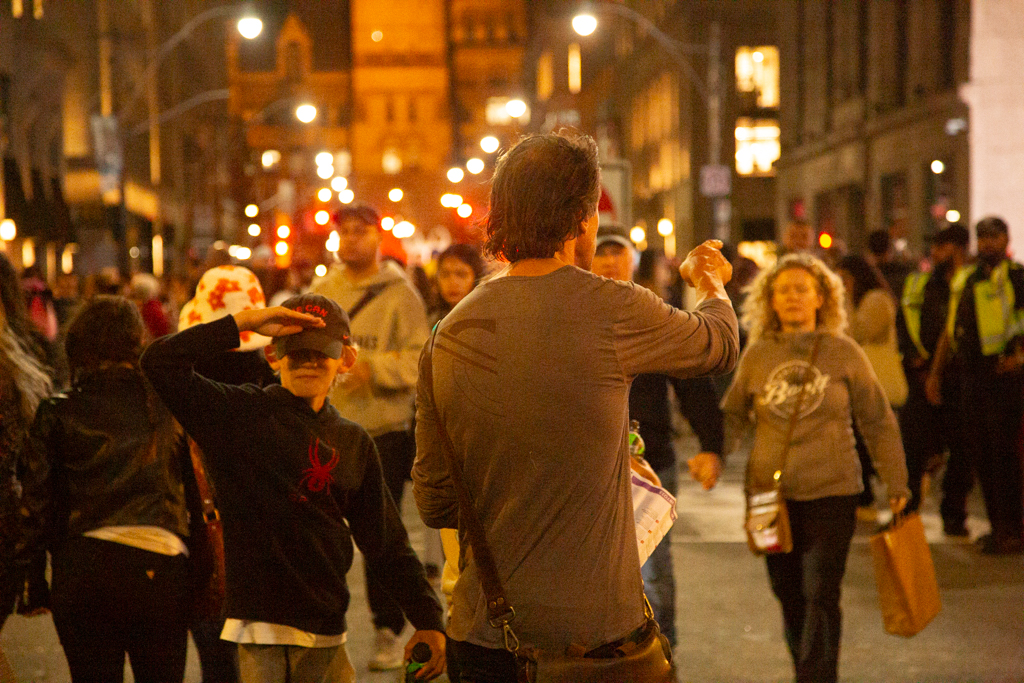
Nuit Blanche’s downtown curator Kari Cwynar says the theme of “Breaking Ground” centres around climate change and nature while questioning the stewardship of the land in which we exist. Cwynar zooms in on Toronto’s financial district—the most evident epicentre of hyper-capitalism and colonialism in the city—focusing the lens on the symbolism and links between money and land.
“I was kind of thinking, well, stewardship of what land? Where is the land in the financial district? It’s not a place in the city where you see the land. It’s a place where the land has been obscured,” says Cwynar.
Hired by the City of Toronto at the start of the year, Cwynar explains how the municipal government invites proposal projects from local curators. Receiving “carte-blanche” on her proposal allows Cwynar to handpick the artists and exhibition sites of her choice.
Cwynar provides guiding questions that might aid in deciphering artworks, “How have our experiences and relationships with the land within urban centres been regulated through the process of colonialism and capitalism?” poses Cwynar. She says the city supports her vision by helping secure site permissions and source production elements—allowing her to fill more of a curatorial, organizational role.
“Confusion surrounding the exhibition is normal––art is challenging,” as TMU Image Centre Exhibitions Curator Gaëlle Morel notes. According to Morel, “Public art is by definition more accessible, therefore more democratic than the Museum institution in general. The Museum institution is generally embedded within colonial hierarchies and practices that can be downplayed in public installations, Morel explains, “where access is not as codified according to Western ideologies.”
Morel sympathizes with Li’s frustration. “Some of us think they don’t know enough, they don’t have the cultural baggage [to] understand concepts,” she says. “Sometimes, people don’t feel welcome in the Museum institution. Having the art outside—proposed to anybody who is on the street as an experience you can engage [with] if you want—I think that’s an interesting process.”
Morel, who holds a PhD in history of contemporary photography, refers to a term used in the art world as the “white cube,” which according to a TATE museum definition, is a modern all-white aesthetic often displayed in showrooms to minimize distractions from the artwork. The concept is the “neutral standard” for institutions, Morel says. “You want to get out of this very normative space…[of white cube standards and norms] which can be very intimidating.”
During Nuit Blanche, this ‘white cube’ is subverted through the white night.
First-year TMU nutrition student Kimia Oshagi passively floats through her social media feed until she notices a pattern. The people are buzzing about an upcoming night of art. Hashtags, stories and posts alike, she gets that feeling—the fear of missing out. Connecting with some friends, they take their bets on what the conspicuous craze holds.
The frenzy is non-stop in Toronto’s downtown core. Mistaken for a mysterious—spooky, perhaps—peaceful evening, Oshaghi and Li admittedly enter amidst an ongoing exhibit. Despite deciding to attend Nuit Blanche at the last minute, both students note their appreciation for public art and the need for local exhibits.
Their blank expressions meet OCAD University professor and Anishinaabe artist Bonnie Devine’s ambiguous sculpture, Circle of Enquiry for a Dish with One Spoon. The word itself, ‘enquiry,’ begs the audience to question anti-colonial narratives. Devine utilizes a reed grass plant called “phragmites” as a physical embodiment of colonialism.
“Phragmites have been designated by the province of Ontario and the City of Toronto as an invasive species. And because they’re invasive, [it] means they didn’t come from here. They are non-native, introduced species that have become predatory,” says Devine during a Q&A session post-presentation.
The colonial narrative follows as Devine explores the ways in which an Indigenous artist like herself goes about sourcing material within native, stolen land. “[Phragmites] have no natural enemies, they have become a threat to the other plant species in the region, to the water lands [and] to the animals that live in those waters. And as such, the Government of Canada has a policy of [eradication],” adds Devine.
Devine furthers the public’s queries as a line of eager attendees await to call into question the artist’s inspiration. Amongst the varied congratulations and appreciation remarks, an attendee asks about the curious sculpture and Devine elaborates on the difficulty in acquiring its material.
“Phragmites have been declared undesirables,” Devine’s voice echoes across the concrete jungle walls. “They have been declared garbage.” She says her team had “very strong protocols” when gathering the material, including how to avoid propagation and spread.
In December 2019, The City of Toronto enacted a Public Art Strategy—a decade-long incentive that “includes 21 actions to enhance the city’s commitment to public art,” according to its webpage.
“Embedded within the commitment to Indigenous communities through truth and reconciliation, this becomes the newly appointed foundational principle for public art,” states the strategy. The aim is to address the lack of Indigenous cultural representation in the public scope. This places Toronto in a role to build a “collection of public art unlike any other in the world”—deeply woven into the interconnection of various media for the cultural expressions of Indigenous identity.
Devine’s inquiry demands just that, as she describes the policies surrounding the regulation of phragmites in relation to the colonial frameworks of the land.
After being told to cut off the phragmites seed heads and place them in a “special bag” for the exhibit, Devine says the phragmites were destined to be set ablaze for six weeks the next day before finally composting. “I don’t know how dangerous it is, but I’m thinking we need a new way to relate to this. I worry about the way that we’re handling the natural world,” expresses Devine.
Devine had two students and a teacher from the Toronto District School Board (TDSB) with her while gathering the reeds on Sept. 25, with aid from the Turtle Protectors, an Indigenous-guided stewardship program that is supported by Indigenous Elders and community members.
The TDSB now has an Indigenous education program with a student interest in ecological matters. “They attach [students] to us so that we can mentor them. They’re aspiring artists, and they’re very interested in knowing how [we] build something like this. And how [we] work with the City of Toronto and with the banks. The bank agreed to this and let us do this. So how does all of that happen?” adds Devine. “We’re interested in working with those students to help them build confidence.”
Sourced from Grenadier Pond in High Park, the phragmites collection process was made possible with the help of 10 members of the Toronto Parks Department. “The City of Toronto Parks Department came and helped us because when they found out that I wanted to gather this particular plant, they were very anxious to help us do it because they’re trying to root them out,” recalls Devine.
With a U-Haul van and a team of eight—including two Indigenous students—the Nuit Blanche crew along with four other volunteers completed the piece in 12 hours.
“It reminds me of penal colonies. It reminds me of refugee camps. It reminds me of tent cities. [And] people or things that are declared unwanted. I wanted to work with them. Because I believe that the only way that we are going to assimilate everyone, or bring them into the family, or understand our relation to everything, is by working with them. Not by isolating and destroying,” says Devine. “Our people were annihilated, and exterminated and declared unwelcome by an invasive species who came here in the millions. And I’m talking about colonization.”
As the financial district weaves in the relationship of colonialism and physical embodiments of the environment, closer to TMU, Crack in the Case explores humans and their impact on nature.
Third-year fashion student Catherine Lejarde, also a Nuit Blanche first-timer, through circulations of posts on Instagram, recalls a poster of a 2022 Nuit Blanche rave that she wasn’t able to attend. Having never embarked on her first sleepless night, she takes the leap this year.
At TMU’s campus, in The Innovation Studio on 110 Bond St., Lejarde attends her first exhibit—Crack in the Case by independent artists a part of elsewhere collective. With a dystopic feel, junk “takes over the environment,” describes Lejarde. “A bunch of foliage over TV sets, kitchen supplies and stuff like that. An overgrowth of nature. What we as humans basically leave behind.”
The guiding principles of TMU’s fashion program flood Lejarde’s mind, including themes of sustainability and textile waste. She often witnesses the product of “our human waste”––Lejarde refers to the issues of textile waste in Ont. According to a 2022 study done by the Seneca College School of Fashion, which analyzed over 1700 kg––approximately 10,700 items––of textile waste collected from Ont. municipalities between 2019 to 2020, textiles amounted to “4.4 per cent of residential waste streams.” Within the same study, data collected in 2018 showed 65 per cent of Ont. waste could be “reused,” and 21 per cent could be repurposed.
When observing the visual artwork of leaves, vines, and roots interpreted through fashion’s critical relation to waste, Lejarde refers to a “rebirth of nature”––emerging, as the artist interprets Nature as personifying and absorbing traits of the cruelty of ‘human-nature’––“from the waste and this destruction caused by people.”
Witnessing creatives embracing sustainability, Lejarde says, inspired her own reason to pursue sustainability within fashion. “Fashion design is one of the most wasteful industries, which is heartbreaking. Something I’m investigating right now is textile development. Finding new ways to create textiles through waste,” she says.
Nathan Phillips Square, a short walk from the TMU campus, is where the shadow on Toronto’s ‘sleepless-night’ feels the darkest. Jenine Marsh’s piece, Wellspring, consists of an exoskeleton of the once-glistening ice rink, pennies and coins shine along the base of the square. Peering in, your vision meets a vignette with bronze-like feet sculptures, eyes straining to see through the dimmed shadows. The floor of the square becomes the city’s trash bin.
The square at night looms large and dark––perfect for the installation’s theme. “Jenine Marsh [makes] an intervention into that space. She was trying to find the right ways of lighting it with what worked with the [square]. The goal wasn’t to make it a completely theatrical space, it is to illuminate what’s already there,” Cwynar says.
Public art imposes itself on you. It demands your undivided attention, perception and interpretation.
Morel says, “When the art is outside for free, there for the public to experience, the artists are not asking you to make the same effort. Actually, the artists are proposing an idea to you, inviting you to experience art as it stands before you, as you are, living life.”
‘Sleepless Night’ reminds us of our space as settlers in the land of so-called ‘Oh, Canada.’

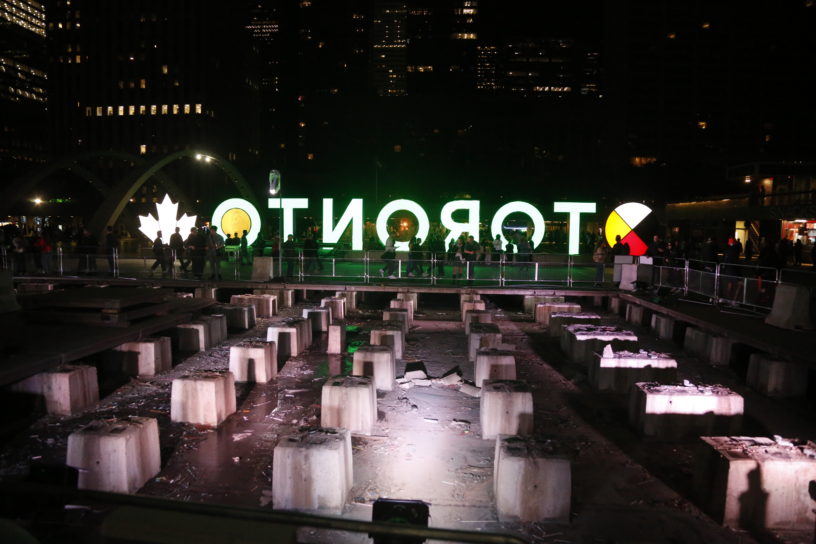
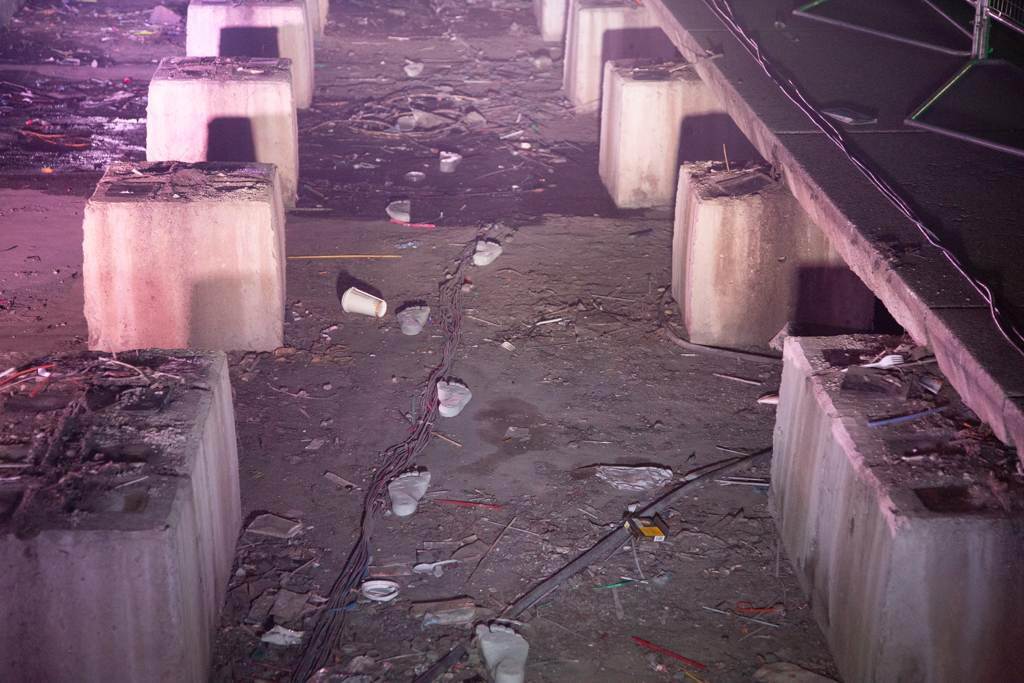
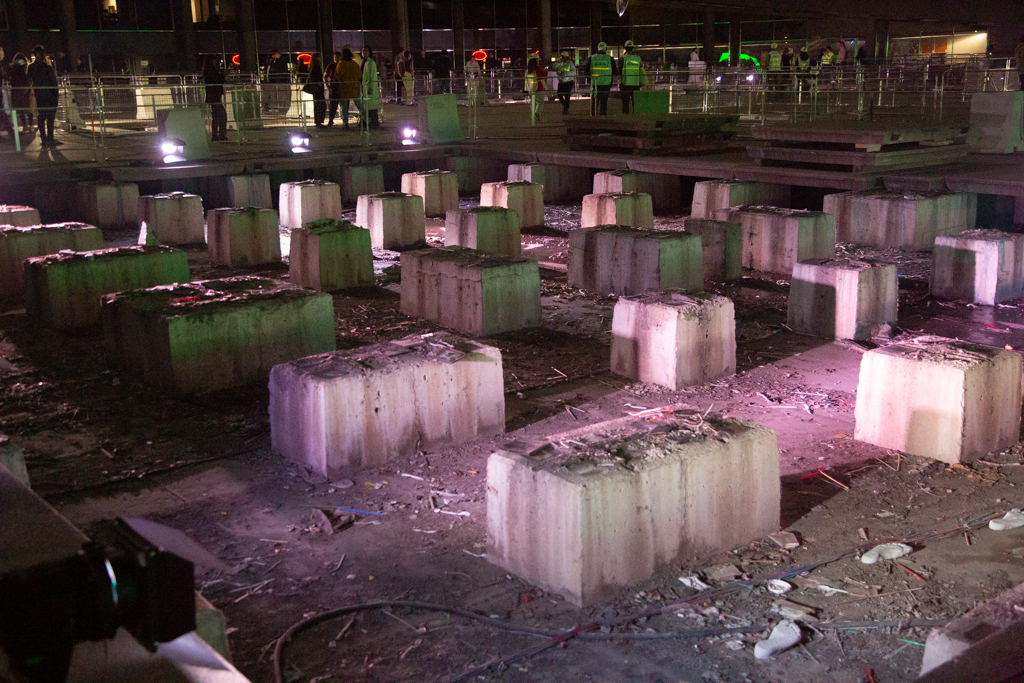
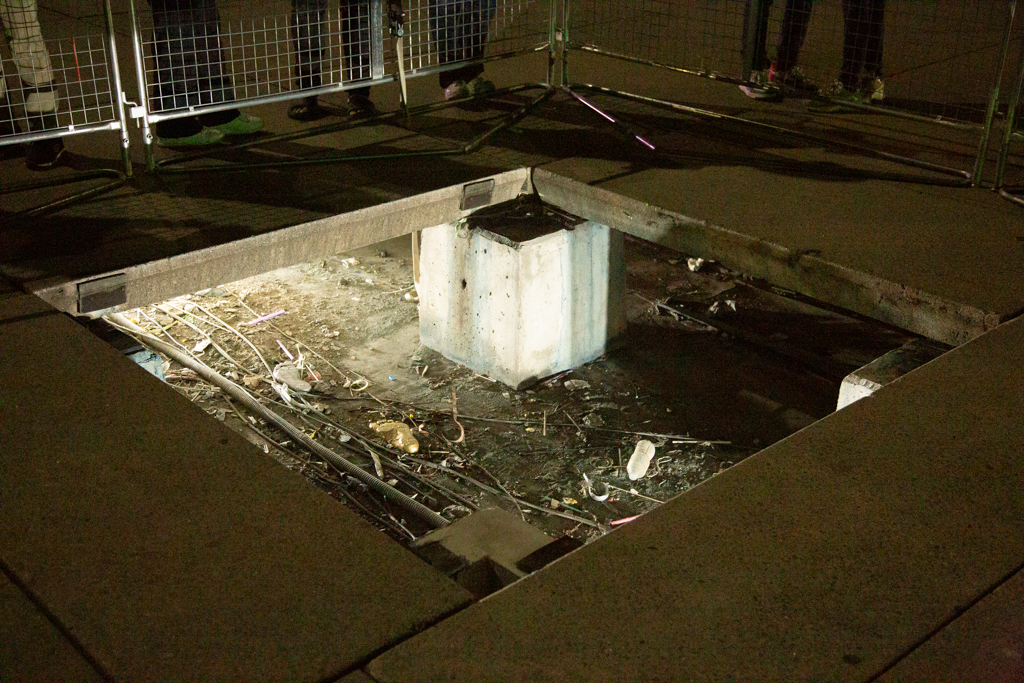
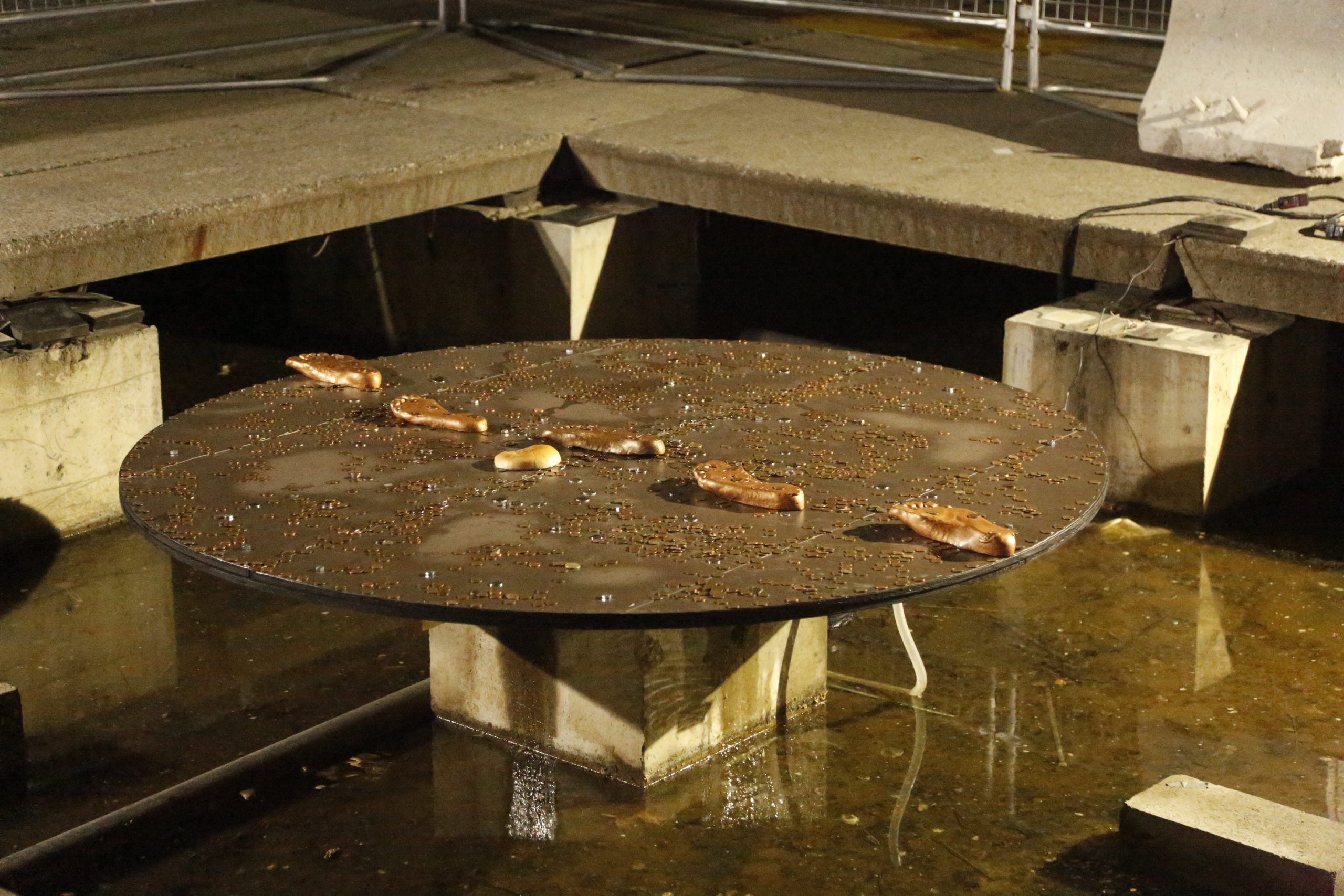








Leave a Reply